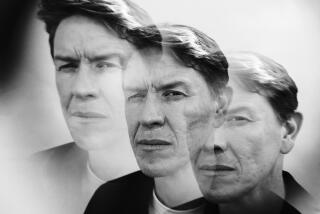Appreciation: Max von Sydow, a pillar of world cinema, brought peerless depth and beauty to the screen
- Share via
The greatest actors in the history of cinema, with careers as rich and versatile as they are long, can perhaps expect their obituary headlines to show an equivalent range. As the news spread Monday morning of Max von Sydow’s death, most articles led with the unsurprising invocations of his famous roles in “The Exorcist” and “The Seventh Seal,” two rare movies that genuinely warrant that oft-abused word “iconic.”
But if Von Sydow was an icon, he was a marvelously nimble and eclectic one — the universally revered titan of the art house who could also be the winking éminence grise of the multiplex. And so naturally there were headline shout-outs to his more recent pop-cultural contributions, namely those fantasy juggernauts “Game of Thrones” and “Star Wars: The Force Awakens.” I counted more prominent mentions of “Shutter Island,” “Strange Brew” and “Flash Gordon” than of Von Sydow’s emotionally wrenching performance in “Pelle the Conqueror,” one of only two films that earned him an Oscar nomination. Beating all comers, perhaps, was the website ghostbustersnews.com, which proudly trumpeted its own spin on the sad news: “Max von Sydow, Voice of Vigo in ‘Ghostbusters 2,’ Dies at Age 90.”
And why not? It is one thing to stare down Death and the Devil, but how many performers could lend such pitch-perfect rumbling gravitas to a line like, “On a mountain of skulls, in a castle of pain, I sat on a throne of blood”? Von Sydow, the only actor who can claim to have worked with Ingmar Bergman, Martin Scorsese and Brett Ratner, was not one to draw condescending distinctions between high and low. Often hailed as a figure of towering physical and dramatic stature, an avatar of brooding high seriousness, he also delighted in puncturing that seriousness and inviting his audiences to do the same.
The error lies in assuming that the seriousness and the playfulness were ever exclusive modes to begin with. In fact, he rendered them inextricable. You can see this in his 11 feature-length collaborations with Bergman, whose oeuvre is often described — understandably, but myopically — as a compendium of doom, gloom and psychological extremity. But look closely at that same oeuvre and you will find considerably more: feverish eroticism, diabolical wit, endless beauty and intensely mercurial flurries of feeling.
And these qualities found an extraordinary vessel in Von Sydow, who could make even a grim scowl a joy to behold. His face — even in the hands of Bergman, a director renowned for his intense, sculptural close-ups — can rightly be memorialized as one of the most expressive landscapes in cinema, an instrument capable of projecting gravity and earnestness, spiritual angst and furious desire. Features as majestic and indelible as granite could nonetheless give rise to expressions as mercurial as water.
He could play endless varieties of torment: a defeated villager’s pathos and paranoia in “Winter Light” (1963), but also a grieving father’s lust for revenge in “The Virgin Spring” (1960). He showed us, in “Shame” (1968), how an ordinary civilian can descend into coldblooded moral oblivion. And few actors have ever wrought more variations on the ravaged artist, to the point of becoming an inevitable stand-in for Bergman himself, as he did when he played a painter succumbing to his demons in “Hour of the Wolf” (1968). But he and Bergman could also position the artist as a figure of cryptic mastery and superior knowledge, as they did in “The Magician” (1958), in which Von Sydow donned a top hat and a dark goatee and, for much of the movie, spoke nary a word.
Von Sydow could work such eloquent wonders with silence, as he did when he played a kindly mute in 2011’s “Extremely Loud & Incredibly Close” (the role that earned him his second Oscar nomination, and hardly the only example of him giving a fine performance in a dreadful movie). But he also possessed one of the medium’s great voices, and he let it rip in epic dramas like “The Emigrants” and “The New Land,” among several films he made with another Swedish master, Jan Troell, in a collaboration as rich and sustained as his work with Bergman.
Nearly three of Von Sydow’s finest hours can be found in Troell’s 1996 opus, “Hamsun,” in which he played the Nobel Prize-winning Norwegian writer and unrepentant Hitler defender Knut Hamsun. It’s a performance that gave monumental form to one of the more challenging and still-relevant phenomena of our age: the great artist who is also, on one level, an indefensible human being.
Von Sydow was an actor nearly all his life. He knew what he wanted to do as early as his teenage years, when he entered Sweden’s Royal Academy of Dramatic Arts and shortly thereafter became a leading star of the stage. But his career never calcified into venerable poses or received wisdom. He was the performer as restless experimenter, who never stopped channeling his art into new experiences and new emotional tributaries.
It was perhaps only natural that his range would seem to unite such striking polarities of human — and sometimes superhuman — experience. He gave voice to the Devil in R.O. Blechman’s 1984 animated adaptation of “The Soldier’s Tale,” and he also played Jesus in George Stevens’ “The Greatest Story Ever Told” (1965). He was one of the cinema’s great doubters, and one of the cinema’s great clergymen — not only in “The Exorcist,” where he transcended layers of old-age latex to create an enduring figure of Christ-compelled fury, but also in George Roy Hill’s lesser-known “Hawaii” (1966), in which he played a dogmatic minister on a very different but no less arduous mission.
He could do all that and still be a Bond villain, a campy outer-space villain and, in Sydney Pollack’s “Three Days of the Condor” (1975), a deeply memorable villain, in a performance whose quietly haunting chill hasn’t dissipated in the two decades since I first saw it. It’s true that Von Sydow made his name by matching wits with the Devil and losing. But it is hard to look back at a career this immortal and say, definitively, which of them has had the final laugh.
More to Read
Only good movies
Get the Indie Focus newsletter, Mark Olsen's weekly guide to the world of cinema.
You may occasionally receive promotional content from the Los Angeles Times.










